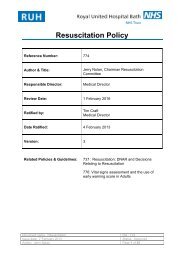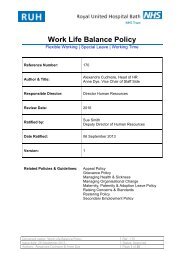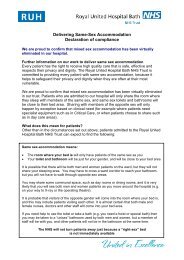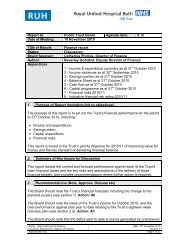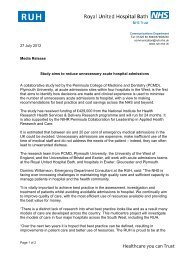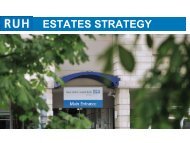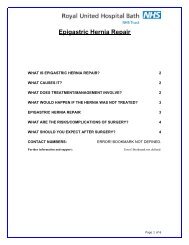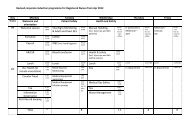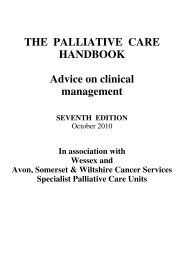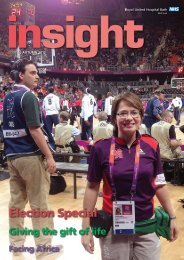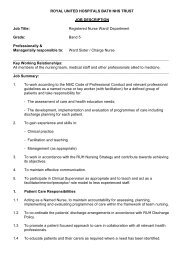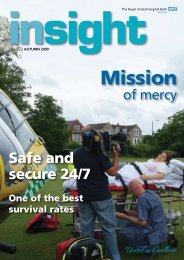Web Content & Editorial - Royal United Hospital Bath NHS Trust
Web Content & Editorial - Royal United Hospital Bath NHS Trust
Web Content & Editorial - Royal United Hospital Bath NHS Trust
- No tags were found...
Create successful ePaper yourself
Turn your PDF publications into a flip-book with our unique Google optimized e-Paper software.
<strong>Web</strong> Policy<strong>Content</strong> and <strong>Editorial</strong> – Reference 321Policy Name & ReferenceNumber:Author & Title:321Louette Eagles, Pete Suters<strong>Web</strong> DevelopersResponsible Directorate:ISDReview Date: October 2015Approved/Ratified by:Lisa Hunt, Chief Operating OfficerDate Approved/Ratified: 12 October 2012Version: 3Related Policies & Guidelines:Policy 218: Policy for the Development andManagement of Procedural DocumentsDocument name: <strong>Web</strong> <strong>Content</strong> and <strong>Editorial</strong> Policy Ref: 321Issue date: October 2012Status: ApprovedAuthors: Louette Eagles and Pete Suters Page 1 of 27
Index:Amendment History ________________________________________________ 2Summery and Objectives ___________________________________________ 3Policy Statements _________________________________________________ 3<strong>Web</strong> Team Services ________________________________________________ 4Working with our Clients: ___________________________________________ 71.0 Adding/Changing <strong>Web</strong> <strong>Content</strong> _____________________________________ 72.0 <strong>Content</strong> Ownership _______________________________________________ 83.0 Audience appropriate <strong>Content</strong> _____________________________________ 104.0 Good Practice when writing for the <strong>Web</strong> _____________________________ 105.0 Copyright and <strong>Royal</strong>ty Free _______________________________________ 126.0 Converting Documents to PDF _____________________________________ 137.0 Videos _________________________________________________________ 148.0 Microsites ______________________________________________________ 159.0 Corporate Branding and Documents ________________________________ 15Definitions/Glossary ______________________________________________ 16Policy Review ____________________________________________________ 17Compliance Monitoring ____________________________________________ 17Appendix 1: Checklist for <strong>Web</strong> <strong>Content</strong> & Documents ___________________ 18Document Control Information ______________________________________ 19Ratification Checklist___________________________________________________ 19Consultation Schedule _________________________________________________ 20Equality Impact: (A) Assessment ________________________________________ 21Equality Impact: (B) Full Analysis ________________________________________ 22Amendment HistoryIssue Status Date Reason for Change Authorised2 Replaced March 2009 Minor updates from previous Geoff Cross3 Approved 12 October2012Policy rewritten to includeinformation about Audienceappropriate content, guidanceon using images,Accessibility, Video usageand MicrositesLisa Hunt,ChiefOperatingOfficerDocument name: <strong>Web</strong> <strong>Content</strong> and <strong>Editorial</strong> Policy Ref: 321Issue date: October 2012Status: ApprovedAuthors: Louette Eagles and Pete Suters Page 2 of 27
Summary and ObjectivesThis policy is relevant to all heads of departments and members of staff who haveresponsibility for updating, adding or removing information on the internet, intranetand extranet on behalf of their departments.Information on the websites has to be: relevant to the target audience; well written;up to date; and, accessible.Information (content) on the <strong>Web</strong>sites belongs to the respective departments and itimportant that each department notifies the <strong>Web</strong> Team of any changes within theirdepartment.Ensuring that information on the websites are accessible to everyone, includingpeople with disabilities, are the responsibility of the web team, who will work closelywith our clients (the content writers) to ensure that every reasonable step is takenmeet legal requirements.Good navigation and graphic design are also looked after by the <strong>Web</strong> Team.In summary: this policy will guide staff, who look after the web content for theirdepartment, through the: how to approach writing web content; how the <strong>Web</strong> Teamcan assist them; the options in respect of video usage, document styles andformatting; and, criteria for Microsites.Policy Statements1. Each department is responsible for their own content2. <strong>Content</strong> must be audience appropriate3. Information found on other websites may be subject to copyright and royalties.4. The information on the web should be, as far as possible, be accessible toeveryone, including people who are blind, partially sighted and dyslexic.Document name: <strong>Web</strong> <strong>Content</strong> and <strong>Editorial</strong> Policy Ref: 321Issue date: October 2012Status: ApprovedAuthors: Louette Eagles and Pete Suters Page 3 of 27
<strong>Web</strong> Team ServicesOur core service1.1. MaintenanceApproximately 5,500 web pages make up the 3 RUH websites described inthe introduction. The team adds, remove and amend information on the sitesas directed by the organisation or the team’s maintenance schedule.1.2. Designa. New pages & Sectionsb. Microsites1.3. NavigationLinks that allow you to move from one section to another via a logical andobvious route. The aim is always to get a user to the relevant informationwithin three clicks1.4. Search Engine maintenance and updatesUpdates and maintenance are done on a weekly basis, or whenever newpages have been added or removed, to ensure the search function on thewebsites perform properly.Where appropriate the team will contact departments and request information;suggest reviews of the information on the site(s); or, suggest a redesign of the webpages.The <strong>Web</strong> Team aims to complete emailed requests for amendments within 24hours and most are done on the day the request is received. When workloadsdemand it, requests will be triaged and work carried out accordingly.Where appropriate, normally for new pages or complex changes, one of the team willcontact the client (author) to discuss the changes and the target date for publication.A link to the development site may be sent to the client, prior to publication to allowthem to review and approve the page(s).Document name: <strong>Web</strong> <strong>Content</strong> and <strong>Editorial</strong> Policy Ref: 321Issue date: October 2012Status: ApprovedAuthors: Louette Eagles and Pete Suters Page 4 of 27
Additional ServicesThe <strong>Web</strong> Team also provides the following services:a. Graphic Design Service for print and electronic use, including logos andoverall brandingb. Information Architecture; organising information into a logical order. Doneproperly, this will ensure documents and information for websites have a goodflow and reads well.c. Chargeable web design and maintenance services to independentorganisations that are related to the <strong>NHS</strong>d. Assistance with, and training for, the formatting of documents to corporatebranding standardse. Creating electronic forms. Where appropriate training can also be provided.f. <strong>Web</strong> performance analysis – monthly or by request for specific sections on allsites.Audience Specific <strong>Web</strong>sitesThe RUH provides an up to date, reliable and informative service for patients, GPsand staff via the RUH websites; the Intranet, Internet and Extranet.The different websites service the following audiences:1.1. Intranet for Staff (http://intranet accessible only from within the RUH)1.2. Extranet for Staff and other <strong>NHS</strong> employees (this site can only beaccessed from <strong>NHS</strong> computers and consists of:o Confidential contact information for General Practices:http://nww.ruh-bath.nhs.uk/For_Clinicians/GP_contacts/index.aspo Pathology Test informationhttp://nww.ruhbath.nhs.uk/For_Clinicians/pathology/reference_ranges/assayindex.aspo Training and eLearning for RUH and Community staff:http://e-learning/new_elearning/index.asp1.3. Internet for Patients & Visitors:o www.ruh.nhs.uk/patientso Microsites to non-core services and information, e.g.• www.ruh.nhs.uk/art• www.ruh.nhs.uk/sexualhealthMore information about microsites can be found in Section 81.4. Internet for General Practices (GPs, Practice Nurses and Managers):o www.ruh.nhs.uk/gps1.5. Internet Prospective employees:Document name: <strong>Web</strong> <strong>Content</strong> and <strong>Editorial</strong> Policy Ref: 321Issue date: October 2012Status: ApprovedAuthors: Louette Eagles and Pete Suters Page 5 of 27
o www.ruh.nhs.uk/careerso www.ruh.nhs.uk/proudtobeanurse (microsite)1.6. Internet microsites for <strong>NHS</strong> and Private patients and ProspectiveClients:o www.ruh.nhs.uk/ssd (sterile services),o www.ruh.nhs.uk/occupationalhealth,o www.ruh.nhs.uk/BFC (<strong>Bath</strong> Fertility Centre)More information about microsites can be found in Section 8The Team can be contacted on:Telephone: 01225 82 4474 or 01225 82 1260Email: ruh-tr.webteam@nhs.netDocument name: <strong>Web</strong> <strong>Content</strong> and <strong>Editorial</strong> Policy Ref: 321Issue date: October 2012Status: ApprovedAuthors: Louette Eagles and Pete Suters Page 6 of 27
Working with our Clients:1.0 Adding/Changing <strong>Web</strong> <strong>Content</strong>Information can be added to the web sites at the request of key contactswithin departments (section 2: <strong>Content</strong> Ownership applies).All changes, except Procedural Documents (Policies and Guidelines) can besent directly to the <strong>Web</strong>team by email: ruh-tr.webteam@nhs.net.Patient Leaflets can only be sent to the <strong>Web</strong> Team after it has been checkedby the Communications Team. Leaflets should be sent to them byemail: ruhcommunications@nhs.net.In GeneralChanges to existing pages:When requesting changes to existing page, please include a link to the pagethat needs changing.a. Minor corrections:Either:i. Copy the content of the section or page and clearly mark the change(s)in your email.ii. Or provide description of the change, e.g. on www.ruh.nhs.uk/gps pleasechange the telephone number forX-Department from 01225 82 1234 to 01225 82 4321.b. Major changes:Provide new content and instruction on which page or section should bereplaced.New web pages/sections:Information should be provided as a word document.Procedural Documents (Policies & Guidelines)All procedural documents are formally controlled and all Policies andGuidelines have to follow the procedure set out in the Policy for Developmentand Management of Procedural Documents. Once approved, these documentshave to be submitted to the Policy Coordinator, who will ensure the policy isadded to the websites.Please note: No procedural document will be added to the websites until thePolicy Coordinator has received a signed Ratification Assurance Statement.Document name: <strong>Web</strong> <strong>Content</strong> and <strong>Editorial</strong> Policy Ref: 321Issue date: October 2012Status: ApprovedAuthors: Louette Eagles and Pete Suters Page 7 of 27
Patient LeafletsFollowing the approval of the Branding Guidelines, a register for all PatientLeaflets was created by the Communications Department(ruh-tr.communication@nhs.net). This department checks the documentformatting and language used in the leaflets before allocating a registrationnumber. The document is then returned to the owner.The document can then be sent to the <strong>Web</strong> Team, with instruction of where itshould be listed.No Patient Leaflet can be added to any website unless it has been checkedby, and registered with, the Communications Team.2.0 <strong>Content</strong> Ownership<strong>Content</strong> ownership refers to all the information published on the websites,including documents. Although the content is published on the websites bythe <strong>Web</strong> Team, the content is owned by the department/author who submitsthe information for publication.The following applies in regard to content ownership:2.1 Responsibility for <strong>Content</strong>The Heads of Departments are responsible for ensuring that theinformation, pertaining to their departments, are kept up to date on theall the websites; and, that any changes are sent to the <strong>Web</strong> Team.Authors submitting documents and information to be published on theweb, have to ensure they are duly authorised to do so; and, that thecontent or changes have been approved according to localdepartmental processes.2.2 Permission to use <strong>Content</strong>It is the responsibility of authors to ensure they have permission to useinformation that are not their own. (see Section 5: Copyright and <strong>Royal</strong>tyfree).2.3 Information Governance and version controlThe risk of links to documents not working (broken links) are minimisedby documents being replaced on the websites. The <strong>Web</strong> server is nota Document Management system and it is the authors’ responsibility toensure they keep version controlled documents in accordance withInformation Governance guidelines, as appropriate.Document name: <strong>Web</strong> <strong>Content</strong> and <strong>Editorial</strong> Policy Ref: 321Issue date: October 2012Status: ApprovedAuthors: Louette Eagles and Pete Suters Page 8 of 27
2.4 PDF to Word conversionsWhere no copy of a document is available (normally when the authorhas left the <strong>Trust</strong> or in cases of misfiled or lost information), the<strong>Web</strong>team can convert PDF documents back to Microsoft Word.However, the format of the layout may be compromised during theconversion and it is up to the (new) author to check and correct anychanges.Approval to publishWith the exception of Procedural documents and Patient Leaflets, the <strong>Web</strong>Team will assume that the submitted content or changes have been approvedat department level and that the person submitting the information has theauthority to do so.Although this assumption of approval may be considered poor informationgovernance, the <strong>Web</strong> Team manages the risk by:a. Insisting that all instructions are received by emailb. Keeping a record of all emails received to create an audit trailc. Building a working relationship with authorsd. Researching any new authors, by means of global address book checksand calling authors on their internal telephone numbers.Audit TrailIn order to maintain the audit trail, all information and change requests mustbe supplied to the <strong>Web</strong> Team by email: ruh-tr.webteam@nhs.net.All emails are stored and archived regularly by the <strong>Web</strong> Team.Document name: <strong>Web</strong> <strong>Content</strong> and <strong>Editorial</strong> Policy Ref: 321Issue date: October 2012Status: ApprovedAuthors: Louette Eagles and Pete Suters Page 9 of 27
3.0 Audience appropriate <strong>Content</strong>When writing for the web it is important to remember your target audience.One should never try to address different audiences in one document or webpage. Although this means writing three different pieces, it is ultimately easierto write when a specific audience is addressed; it ensures better content; and,it avoids confusing and patronising different groups of readers.Take as an example, a medical procedure:• Writing for RUH clinicians (intranet) allows one to describe proceduresin detail and to use terminology and graphics that will be understood byother RUH clinicians and staff.• General Practitioners want to know that we do perform the procedure,what the referral criteria are, the success rates and how to refer to theservice.• Patients want to know what to expect, what will be done and how long itwill take to recover; without any jargon and in plain English.4.0 Good Practice when writing for the <strong>Web</strong><strong>Content</strong> of documents and webpages should be checked against the followingguidance prior to being forwarded to the <strong>Web</strong> Team for publication to the<strong>Trust</strong> web sites.4.1. <strong>Content</strong> must be audience appropriate(See section 3: Audience appropriate content)4.2. When writing content for web pages (as opposed to documents), it isimportant to note that people rarely read text from a screen word byword, preferring instead to scan pages, picking out individual wordsand sentences. Before you start authoring a new web page, pleasetake a look at our guidance on how to write for the web (this link is onlyaccessible to RUH staff).4.3. When they first occur, abbreviations and acronyms are written in fulland followed by the abbreviation or acronym in brackets.4.4. Do not underline text. Underlining is often an indication of a hyperlinkand should therefore be avoided in ‘flat’ text.4.5. Do not use CAPITAL LETTERS. It is shouting on paper/screen and notacceptable. Instead use bold or different size font to emphasise apoint.Document name: <strong>Web</strong> <strong>Content</strong> and <strong>Editorial</strong> Policy Ref: 321Issue date: October 2012Status: ApprovedAuthors: Louette Eagles and Pete Suters Page 10 of 27
4.6. Do not use any font size smaller than 12 points in a document. Use of10 point font is acceptable in tables.4.7. Only use Arial and Frutiger as they are the Corporate Brandingapproved fonts.4.8. Where possible avoid the use of cartoons.4.9. Captions should accompany all graphs, pictures and - where relevant –graphics.4.10. Coloured text alone should not be used to convey meaning. Forexample in forms do not say, “All fields marked in red are obligatory” asthe colour difference won't be conveyed to screen reader or Brailleoutput users. Use red together with an asterisk (*). This will then beclearly visible to users with monochrome browsers and conveyed tospeech and Braille output users.4.11. Colour blindness and DyslexiaColour blindness affects the way that certain colours appear. Red andgreen, for instance, can appear identical to affected users. Ensure thatyou choose colours that have a good differentiation for people withcolour perception difficulties.People with Dyslexia often find that high contrasts assist their reading.Good colour contrasts such as Black and white or black and yellow areexamples of excellent contrasts.Note:A simple test for point 5.10 and 5.11 is to print the document in black and white. Ifthe document has lost some of the meaning, reconsider the use of colour.4.12. Hyperlinks:a. In a document use the full URL: e.g. www.ruh.nhs.uk/gps. When thedocument has been printed it will allow the user to access the site.b. On a web page a description of the link can be used, e.g.: <strong>Web</strong>site forGeneral Practitioners.4.13. Do not use documents or include sections of a document that has beenscanned. Such documents/text cannot be read by screen readingtechnologies, e.g. those available to the visually impaired. Theinclusion of scanned items also results in very large files.(Appendix 1 contains a printable content checklist)Document name: <strong>Web</strong> <strong>Content</strong> and <strong>Editorial</strong> Policy Ref: 321Issue date: October 2012Status: ApprovedAuthors: Louette Eagles and Pete Suters Page 11 of 27
5.0 Copyright and <strong>Royal</strong>ty FreeDefinitionsCopyright is defined as: the exclusive legal right to reproduce, publish, sell,or distribute the matter and form of something (as a literary, musical, or artisticwork)<strong>Royal</strong>ty-free, or RF, refers to the right to use copyrighted material orintellectual property without the need to pay royalties for each use or pervolume sold, or some time period of use or sales.Note: Do not assume that you have permission to use information justbecause it is royalty-free. <strong>Royal</strong>ties refer to payment, not permission.<strong>Content</strong>Even if it is not specifically stated that content is copyright protected, it doesnot mean anyone can use information found on the web or anywhere else.If the work is not your own, the permission of the author should bespecifically obtained, either by letter or email. The permission should be kepton file.ImagesA common misconception is that images found by Google do not havecopyright protection and are royalty-free. This is not true; unless you havespecific permission, you may not assume that you can use any image foundon the World Wide <strong>Web</strong>, regardless of how you found it.If you find an image that you want to use on your department’s web page, it isup to you to contact the owner of the image and to get permission to use theimage; and, if a royalty payment is expected, to pay it. The <strong>Web</strong>team will notobtain permission, nor can we pay for royalty fees.Images that are free to useThe Communications Department and the <strong>Web</strong> Team have an extensivecollection of images that belong to the RUH. These images were taken forand belong to the RUH.Permission to use images of people has been obtained from people whoappear in the photographs, and are kept on file by the CommunicationsDepartment.Note:If an image is found on the internet that is to the client’s liking, the <strong>Web</strong> Teammight be able to provide a similar image from the RUH’s image collection.Document name: <strong>Web</strong> <strong>Content</strong> and <strong>Editorial</strong> Policy Ref: 321Issue date: October 2012Status: ApprovedAuthors: Louette Eagles and Pete Suters Page 12 of 27
Other sources of free to use images are:1. <strong>NHS</strong> Photos Library (http://www.photolibrary.nhs.uk/)2. Microsoft’s clipart and sample art, (www.office.microsoft.com/images)The use of Clipart and Sample art is covered in the End-User Licence(www.microsoft.com/permission).6.0 Converting Documents to PDFDocuments must be sent to the <strong>Web</strong>team in the original form, e.g. Word,Excel or PowerPoint. The <strong>Web</strong>team will convert the documents to accessiblePortable Document Format (PDF) using Acrobat Professional.Unless staff have access to and use Acrobat Professional they must notconvert documents to PDF.The reason for this request is that a number of problems are encounteredwhen documents are converted to PDF using the built in “Print to PDF” inMicrosoft Office (MS). Problems associated with this type of conversion are:• Failing DDA (Disability Discrimination Act 2005) complianceMost screen readers (typically used by blind and dyslexic people)cannot read these PDF documents.• Large file sizesIf the document contains any graphics or spread sheets it can result ina very large PDF file, which are slow to download. It is not unusual tosee a 2 – 6 Megabyte document that was converted by MS Word’sPDF printer.• Links no longer workWith the exception of links to websites, all other links in a document arelost. These include email addresses and content links.PDF to Word conversionsWhere no copy of a document is available (normally when the author has leftthe <strong>Trust</strong> or in cases of misfiled or lost information), the <strong>Web</strong>team can convertPDF documents back to Microsoft Word. However, the format of the layoutmay be compromised during the conversion and it is up to the (new) author tocheck and correct any changes.Document name: <strong>Web</strong> <strong>Content</strong> and <strong>Editorial</strong> Policy Ref: 321Issue date: October 2012Status: ApprovedAuthors: Louette Eagles and Pete Suters Page 13 of 27
7.0 VideosCompliance with the Equality Act 2010 and <strong>Web</strong><strong>Content</strong> Accessibility Guidelines 2.0All videos on the websites must comply with the Equality Act of 2010 whichincorporates the Disability Discrimination Act 2005 (DDA) and and <strong>Web</strong><strong>Content</strong> Accessibility Guidelines 2.0. Rules for compliance include:7.1. Subtitles for Deaf and hard of hearing:There should be sufficient time to read the subtitles, using the readingspeed of someone who is reading English as a second language (forD/deaf people sign language is their first language).7.2. Descriptive Audio for blind peopleDescriptive audio should include a verbal description of facialexpressions, scenery, and anything visual that contributes to theunderstanding of the situation depicted.7.3. Transcript of videoWhere subtitling and audio description is not available, a transcript ofthe video must be provided in a format that can be read by screenreaders (See section 6: Converting document to PDF).Videos and StaffThe use of video on the intranet is not advisable as the majority of the RUH’sStaff computers do not have speakers. Some PCs do have sound cards butstill requires a headset to hear the audio.Videos for the intranet should therefore add value; a surgical procedure withsubtitles is a good use of video but a video of a person talking is not. Adocument with a photo of the person responsible for the message ispreferable to a “talking head”.Document name: <strong>Web</strong> <strong>Content</strong> and <strong>Editorial</strong> Policy Ref: 321Issue date: October 2012Status: ApprovedAuthors: Louette Eagles and Pete Suters Page 14 of 27
8.0 MicrositesDepartments that are not part of the core function of the RUH and/or generateincome for the <strong>Trust</strong> can request a microsite. Microsites are largely free fromthe restraints of the design to the main RUH website.The <strong>Web</strong> Team will work with departments to design a corporate image (ifrequired) and the microsite. Development of these sites takes time andcannot be completed in the normal 24-hour turnaround. They will be added tothe Team’s project list and the publication date will be agreed with the client.Criteria for Microsites:8.1. The site cannot link to, or be part of, the private practice of anyindividual or group.8.2. The department is part of the RUH, but;a. Is not part of the core functions of the RUH and, or;b. Generates income for the RUH.8.3. A header linking the site back to the main <strong>Web</strong>site has to be present onall pages.9.0 Corporate Branding and DocumentsDocument templates are provided for a variety of <strong>Trust</strong> documents.Training notes and templates for staff to use when creating documents can befound on the intranet under Corporate Branding(intranet/staff_resources/corporate_branding/index.asp).Appendix One provides basic formatting guidelines.The <strong>Web</strong> Team will work with authors, if required, to ensure that documentsthat are submitted for publication conform to this policy.Document name: <strong>Web</strong> <strong>Content</strong> and <strong>Editorial</strong> Policy Ref: 321Issue date: October 2012Status: ApprovedAuthors: Louette Eagles and Pete Suters Page 15 of 27
Definitions/GlossaryCopyright<strong>Content</strong>ExtranetPDFInternetIntranetMicrositeNavigation<strong>Royal</strong>ty-free, orRFThe exclusive legal right to reproduce, publish, sell, or distributethe matter and form of something (as a literary, musical, orartistic work)The narrative that tells users about the service<strong>Web</strong>site restricted to the wider organisation, in this case anyoneworking on an <strong>NHS</strong> computer. This allows the organisation tomake information available, such as training and sensitiveinformation to the Health care providers outside the RUH.Portable Document Format<strong>Web</strong>site that can be accessed by anyone with access to aninternet browser<strong>Web</strong>site aimed at staff and only accessible from within theorganisation (RUH)Separately promoted part of a larger websiteLinks that allow you to move from one section to another via alogical and obvious route. The aim is always to get a user to therelevant information within three clicksThe right to use copyrighted material or intellectual propertywithout the need to pay royalties for each use or per volumesold, or some time period of use or sales.Document name: <strong>Web</strong> <strong>Content</strong> and <strong>Editorial</strong> Policy Ref: 321Issue date: October 2012Status: ApprovedAuthors: Louette Eagles and Pete Suters Page 16 of 27
Policy ReviewThis policy will be reviewed every three years by the Head of IM & T or a nominateddelegate.The <strong>Trust</strong> acknowledges that information is a valuable asset, therefore it is wholly inits interest to ensure that the information it holds, in whatever form, is appropriatelygoverned, protecting the interests of all of its stakeholders.All staff, contractors and other relevant parties will ensure that these are observed inorder that we may contribute to the achievement of the <strong>Trust</strong>’s objectives and thedelivery of effective healthcare to the local health community.All staff are required to read, understand and abide by the principles laid down in<strong>Trust</strong> policy documentation. Any incident where <strong>Trust</strong> policy and procedure hasbeen violated by staff (either maliciously or accidentally) may be subject to formaldisciplinary action.More information about Human Resources policies can be found on:www.ruh.nhs.uk/about/policies/hr.aspCompliance MonitoringCompliance with this policy is monitored on a case by case basis, e.g. evaluatingrequests submitted by email and requesting email confirmations of telephone or faceto face meetings.The <strong>Web</strong> Team are gatekeepers of the content added to the web and where doubtexists about requests, the team will discuss this in detail with the originator of therequest to ensure compliance.The policy group validates that policies submitted are compliant with the <strong>Trust</strong> Policy,number 218, for the Development and Management of Procedural Documents.Document name: <strong>Web</strong> <strong>Content</strong> and <strong>Editorial</strong> Policy Ref: 321Issue date: October 2012Status: ApprovedAuthors: Louette Eagles and Pete Suters Page 17 of 27
Appendix 1: Checklist for <strong>Web</strong> <strong>Content</strong> &DocumentsProcess / Item1. The content is audience appropriate (staff, GPs, Patient, visitors,ect.)2. The information has been written in clear and simple languageappropriate to its audience3. When they first occur, abbreviations and acronyms are written infull and immediately followed by the abbreviation or acronym inbrackets4. Captions accompany all graphs, pictures and - where relevant –graphics5. The use of cartoon style clip-art is minimal6. Permission has been obtained, where necessary, to use imagesand/or content7. Hyperlinks are clearly identified, e.g. Sexual Health(http://www.ruh.nhs.uk/sexualhealth/)Document specific issues:8. Corporate Branding has been adhered to in document, e.g. TheRUH logo is positioned at the top right hand side of thedocument, i.e. right justified9. The document will not lose information if printed in black andwhite, i.e. a key to table or graph is not reliant on colour10. It is preferable to use bold or larger font rather than italics orunderlines to emphasize key words11. The text font is either Arial or Frutiger and is at least 12 points12. No scanned documents or scanned sections of a document hasbeen included.Checked13. The document footer contains the appropriate information.14. Documents are submitted to the <strong>Web</strong> Team in original format,e.g. Word, Excel, ectDocument name: <strong>Web</strong> <strong>Content</strong> and <strong>Editorial</strong> Policy Ref: 321Issue date: October 2012Status: ApprovedAuthors: Louette Eagles and Pete Suters Page 18 of 27
Document Control InformationRatification Assurance StatementDearLisa HuntPlease review the following information to support the ratification of the below nameddocument.Name of document:Name of author:Job Title:<strong>Web</strong> <strong>Content</strong> and <strong>Editorial</strong> PolicyLouette Eagles and Pete Suters<strong>Web</strong> DevelopersI, the above named author confirm that:• The Policy presented for ratification meets all legislative, best practice andother guidance issued and known to me at the time of development of thePolicy;• I am not aware of any omissions to the Policy, and I will bring to the attentionof the Executive Director any information which may affect the validity of thePolicy presented as soon as this becomes known;• The Policy meets the requirements as outlined in the document entitled <strong>Trust</strong>widePolicy for the Development and Management of Policies (v4.0);• The Policy meets the requirements of the <strong>NHS</strong>LA Risk ManagementStandards to achieve as a minimum level 2 compliance, where applicable;• I have undertaken appropriate and thorough consultation on this Policy and Ihave documented the names of those individuals who responded as part ofthe consultation within the document. I have also fed back to responders tothe consultation on the changes made to the Policy following consultation;• I will send the Policy and signed ratification checklist to the Policy Coordinatorfor publication at my earliest opportunity following ratification;• I will keep this Policy under review and ensure that it is reviewed prior to thereview date.Signature of Author: Date: 10 September 12Name of PersonRatifying this policy: Lisa HuntJob Title:Chief Operating OfficerSignature:Date:Document name: <strong>Web</strong> <strong>Content</strong> and <strong>Editorial</strong> Policy Ref: 321Issue date: October 2012Status: ApprovedAuthors: Louette Eagles and Pete Suters Page 19 of 27
Consultation ScheduleName and Title of IndividualDate ConsultedDave Wickham: Head of IM&T 16 May 2012Spencer Wensley, Network Support Technician 17 May 2012Simon Edwards, Information Governance Manager 17 May 2012Eric Sanders, William Hubbard, Mark Mallet, Natasha 29 May 2012Zurick, Monica Baird, Clare O'Farrell, AlexandraLucas, Helen Maria, Helen Robinson-Gordon, LizJones, Emma Borowski, Alexandra Cudmore,Roxanne Poultney, Mark Tooley, Dorothy Goddard,Luke Champion, Lucy Twigger, Peter Fox, CindiBedor, Catherine Soan, Pauline Bertrand, DavidWickham, Spencer Wensley, Simon EdwardsThe following people have submitted responses to the consultation process:Name and Title of IndividualDate RespondedDave Wickham: Head of IM&T 17 May 2012Spencer Wensley, Network Support Technician 17 May 2012Simon Edwards, Information Governance Manager 17 May 2012Simon Edwards (second consultation) 29 May 2012Eric Sanders 29 May 2012Mark Mallet 29 May 2012Roxanne Poultney 29 May 2012Natasha Zurick 30 May 2012Luke Champion 30 May 2012Peter Fox 31 May 2012David Wickham (second consultation) 31 May 2012Helen Maria 01 June 2012Cindi Bedor 12 June 2012Name of Committee/s (if applicable)Non Clinical Governance CommitteeDate ofCommitteeDocument name: <strong>Web</strong> <strong>Content</strong> and <strong>Editorial</strong> Policy Ref: 321Issue date: October 2012Status: ApprovedAuthors: Louette Eagles and Pete Suters Page 20 of 27
Equality Impact: (A) AssessmentTo be completed when submitted to the appropriate committee for consideration andapprovalInitial ScreeningLead(e.g. Director, Manager, Clinician):Dave WickhamPerson responsible for the assessment:Name:Louette Eagles and Pete SutersJob Title:<strong>Web</strong> DevelopersIs this a new or existing policy, service strategy, procedure or function?ExistingWho is the policy/service strategy, procedure or function aimed at?PatientsCarersStaffVisitorsAny other:Are any of the following groups adversely affected by the policy?If yes is this high, medium or low impact (see attached notes):Does the policy/guidance affect one group less or more favourably than another onthe basis of the following protected characteristics under the Equality Act 2010Group Affected? CommentsGender:NoTransgender:Disability:learning difficulties, physical disability, sensoryimpairment and mental health problemsAge:Race:Sexual orientation;including lesbian, gay and bisexual peopleReligion/belief:Marriage/Civil Partnership:NoYesYesNoNoYesNoIf the answer is NO to all categories, the assessment is now completeIf any of the answers are YES please complete theEquality Impact: (B) Full Analysis belowDocument name: <strong>Web</strong> <strong>Content</strong> and <strong>Editorial</strong> Policy Ref: 321Issue date: October 2012Status: ApprovedAuthors: Louette Eagles and Pete Suters Page 21 of 27
Equality Impact: (B) Full AnalysisNote:Only complete this section if you answered YES to any of the questions inthe Equality Impact AssessmentEquality Analysis is a process of systematically analysing a new or existing policy orservice to identify what impact or likely impact it will have on different groups within thecommunity. The primary concern is to identify any discriminatory or negativeconsequences for a particular group or sector of the community. Equality Analysis can becarried out in relation to service delivery as well as employment policies and strategies.This template has been developed to use as a framework when carrying out an EqualityAnalysis on a policy, service or function. It is intended that this is used as a workingdocument throughout the process, with a final version including the action plan section beingpublished on the <strong>Royal</strong> <strong>United</strong> <strong>Hospital</strong>, <strong>Bath</strong> <strong>NHS</strong> <strong>Trust</strong> website.1. Identify the aims of the policy or service and how it is implemented.Key questions1.1 Briefly describe purpose of theservice/policy including• How the service/policy isdelivered and by whom• If responsibility for itsimplementation is shared withother departments ororganisations• Intended outcomes1.2 Provide brief details of the scopeof the policy or service beingreviewed, for example:• Is it a new service/policy orreview of an existing one?• Is it a national requirement?).• How much room for review isthere?1.3 Do the aims of this policy link to orconflict with any other policies ofthe <strong>Trust</strong>?Answers / NotesEnsure all websites that we create areaudience appropriate and accessible to allbackgrounds and abilitiesThis is a replacement policy.All reasonable attempts have been made tocomply with the <strong>Web</strong> <strong>Content</strong> AccessibilityGuidelines 2.0 published by W3C, EqualityLaw 2010 and <strong>NHS</strong> Branding guidelines.Reviews will be made every three years, oras required.Not as far as we are awareDocument name: <strong>Web</strong> <strong>Content</strong> and <strong>Editorial</strong> Policy Ref: 321Issue date: October 2012Status: ApprovedAuthors: Louette Eagles and Pete Suters Page 22 of 27
2. Consideration of available data, research and informationMonitoring data and other information should be used to help you analyse whether you aredelivering a fair and equal service. Please consider the availability of the following as potentialsources:• Demographic data and other statistics, including census findings• Recent research findings (local and national)• Results from consultation or engagement you have undertaken• Service user monitoring data (including ethnicity, gender, disability, religion/belief,sexual orientation and age)• Information from relevant groups or agencies, for example trade unions andvoluntary/community organisations• Analysis of records of enquiries about your service, or complaints or complimentsabout them• Recommendations of external inspections or audit reportsKey questions2.1 What is the equalities profile of theteam delivering the service/policy?2.2 What equalities training have staffreceived?2.3 What is the equalities profile ofservice users?2.4 What other data do you have interms of service users or staff?(e.g results of customersatisfaction surveys, consultationfindings). Are there any gaps?Data, research and information that you canrefer to<strong>Web</strong> Developers attended VerseOne(Accessibility) workshops. No trainingrequired for the wider organisation other thanmandatory trainingMixed - all abilities and groupsUsability Testing using a large group ofpeople with a wide range of computerabilities These workshops, run by the <strong>Web</strong>Team, demonstrated the need for reliablesearch engine and navigation. Allsuggestions that came from the groups wereconsidered and most were implemented.Actively involved staff with visual impairmentSite reviewed by visually impaired user usingScreen reading software while attendingVerseOne workshopsContinuous updating of knowledge viainternet and other sourcesExternal website is regularly examined tocheck for any accessibility issues, especialllyin relation to visually impaired.Document name: <strong>Web</strong> <strong>Content</strong> and <strong>Editorial</strong> Policy Ref: 321Issue date: October 2012Status: ApprovedAuthors: Louette Eagles and Pete Suters Page 23 of 27
Key questions2.5 What engagement or consultationhas been undertaken as part ofthis EIA and with whom?What were the results?2.6 If you are planning to undertakeany consultation in the futureregarding this service or policy,how will you include equalitiesconsiderations within this?Data, research and information that you canrefer toThe use of videos have to comply withguidelines to ensure they are accessible toboth D/deaf and Visually impaired users;details outlined in the policy under the Videousage sectionDiscussed the need for this Assessment withthe Information Governance ManagerEnsure both <strong>Web</strong> Developers are up to datewith any changes in the <strong>Web</strong> <strong>Content</strong>Accessiblity Guidelines by attendingVerseOne workshops, normally run whenW3C published new or updated guidelines.Document name: <strong>Web</strong> <strong>Content</strong> and <strong>Editorial</strong> Policy Ref: 321Issue date: October 2012Status: ApprovedAuthors: Louette Eagles and Pete Suters Page 24 of 27
3. Assessment of impact: ‘Equality analysis’Based upon any data you have considered, or the results of consultation or research, use thespaces below to demonstrate you have analysed how the service or policy:• Meets any particular needs of equalities groups or helps promote equality insome way.• Could have a negative or adverse impact for any of the equalities groups3.1 GenderIdentify the impact/potentialimpact of the policy onwomen and men. (Arethere any issues regardingpregnancy and maternity?)3.2 TransgenderIdentify the impact/potentialimpact of the policy ontransgender people3.3 DisabilityIdentify the impact/potentialimpact of the policy ondisabled people (ensureconsideration of a range ofimpairments including bothphysical and mentalimpairments)Examples of whatthe service hasdone to promoteequalityN/AN/AEnsuring thewebsites are ascompliant withW3C guidelines aspossible andregularly auditingthe sitesExamples of actual or potentialnegative or adverse impact andwhat steps have been or could betaken to address thisIf a webpage is not correctly codedit can prevent some groups fromusing the sites. To ensure the agood experience the <strong>Web</strong> Teamfollows good practice such as:Using the correct in thecodeEnsuring all link names makesense if read out of contextUsing code aimed specific atscreen readers, to optimise theusers experience of the siteUsing alternative text to describeimages ( tags).Using Cascading Style Sheets(CSS) - this allows users withDyslexia to use their own CSS toallow for better reading, typicallythey would want to change thecolour of the page to increase thecontrast.Document name: <strong>Web</strong> <strong>Content</strong> and <strong>Editorial</strong> Policy Ref: 321Issue date: October 2012Status: ApprovedAuthors: Louette Eagles and Pete Suters Page 25 of 27
3.4 AgeIdentify the impact/potentialimpact of the policy ondifferent age groups3.5 RaceIdentify the impact/potentialimpact on different blackand minority ethnic groups3.6 Sexual orientationIdentify the impact/potentialimpact of the policy onlesbians, gay, bisexual &heterosexual people3.7 Religion/beliefIdentify the impact/potentialimpact of the policy onpeople of differentreligious/faith groups andalso upon those with noreligion.3.8 Marriage/CivilPartnershipIdentify the impact/potentialimpact of the policy3.9 Pregnancy/MaternityIdentify the impact/potentialimpact of the policyExamples of whatthe service hasdone to promoteequalityText can beincreased ordecreased to suitthe userConsiderationgiven to the use ofreligious symbolsin the Chaplaincyand End of Lifesections of thesite.Examples of actual or potentialnegative or adverse impact andwhat steps have been or could betaken to address thisThis does not only apply to olderpeople but anyone who would likea change in font size to improvereadabilityImagery used in these sections isdeliberately generic, denoting ageneral sense of spirituality ratherthan use of overt symbolsrepresenting specific religiousfaiths.Document name: <strong>Web</strong> <strong>Content</strong> and <strong>Editorial</strong> Policy Ref: 321Issue date: October 2012Status: ApprovedAuthors: Louette Eagles and Pete Suters Page 26 of 27
4. <strong>Royal</strong> <strong>United</strong> <strong>Hospital</strong>,<strong>Bath</strong> Equality Impact Assessment Improvement PlanPlease list actions that you plan to take as a result of this assessment. These actions shouldbe based upon the analysis of data and engagement, any gaps in the data you haveidentified, and any steps you will be taking to address any negative impacts or removebarriers. The actions need to be built into your service planning framework. Actions/targetsshould be measurable, achievable, realistic and time framed.Issues identifiedActions requiredProgressmilestonesOfficerresponsibleBy when5. Sign off and publishingOnce you have completed this form, it needs to be ‘approved’ by your Line Manager or theirnominated officer. Please ensure that it is submitted to the body ratifying your policy orservice change with your report/proposal. Keep a copy for your own records.Signed off by:Date:Document name: <strong>Web</strong> <strong>Content</strong> and <strong>Editorial</strong> Policy Ref: 321Issue date: October 2012Status: ApprovedAuthors: Louette Eagles and Pete Suters Page 27 of 27



